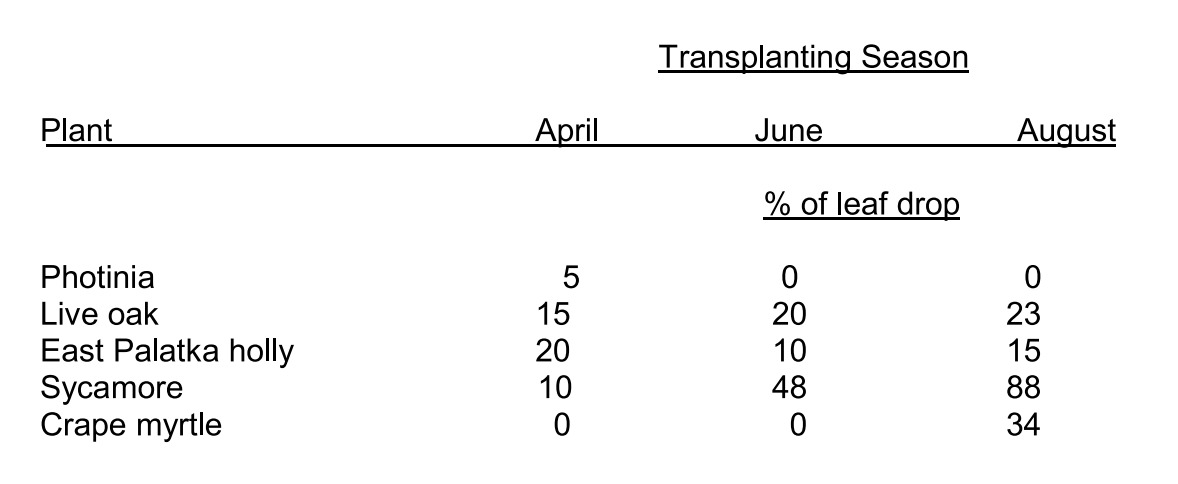Transplanting from Field-Grown Containers
At a glimpse: Discusses transplanting Photinia, Live Oak, Holly, Sycamore & Crape Myrtle
By Uday Yadav, Dewayne Ingram and Bill Reese, University of Florida
From SNA Research Conference Proceedings 1987
“SNA RESEARCH CONFERENCE – 1987”
OBSERVATIONS ON TRANSPLANTING FROM FIELD-GROW™ CONTAINERS IN FLORIDA
By Uday Yadav, Dewayne Ingram and Bill Reese
University of Florida
*This article is reprinted from the proceedings of the SNA Research Conference 1987, page 162. www.sna.org
Nature of Work: Production of landscape trees in fabric containers inserted in the field has increased considerably in Florida in recent years. Possible advantages of this production/marketing system include more rapid growth in the field than in containers for some species but with a degree of root control. In has been suggested that this system offers a reduction in seasonal harvest limitations of conventional methods for field-grown trees because a greater portion of the root system is harvested. The system also provides a unique marketing package (2). Ingram et al (1) reported that some species responded better to this system than others. There appeared to be advantages for producing some species in these in-field, fabric containers (Field-Grow™ Containers, Root Control, Inc., Oklahoma City, OK), however, some landscapers have been somewhat apprehensive about the survivability and establishment of plants transplanted from Field-Grow™ containers to landscape environments. At present, data from comprehensive research for Florida conditions are lacking.
A transplanting study was conducted in Ocala, Florida at Greenbriar Nurseries in a Leon fine sand soil from April 1984 through August 1985. Platanus occidentalis (sycamore) and Lagerstroemia indica (crape myrtle) were transplanted from 1-gallon containers into 14-inch diameter Field-Grow™ containers in April 1984. Quercus virginiana (live oak), Ilex opaca ‘East Palatka’ (East Palatka holly) and Photinia x fraseri (red tip) were transplanted from 3-gallon containers into 16-inch Field-Grow™ containers. An inorganic 16-4-48 fertilizer was incorporated into the native soil backfill at 6 oz. per tree and an equal amount was surface applied every 3 months thereafter. The plants received 7.5 gallons of water daily through a drip irrigation system.
Four plants of each genera were dug by hand in April 1985, June 1985, and August 1985 and transplanted within 1 hour to a simulated landscape site on the nursery in a randomized complete block design. Field-Grow™ containers were removed b cutting with a knife and pulling gently from the exposed roots. Trees were irrigated with a garden hose daily for the first 3 weeks, twice per week for the next 2 weeks and weekly thereafter. Leaf-drop measurements were recorded weekly. Final evaluations were made in October 1985.
Results and Discussion: All plants survived the transplanting in April, June and August. Plant height and stem diameter increased with time (data not shown). In the early spring, all plants except crape myrtle exhibited a slight leaf drop (Table 1). The succulent growth on photinia wilted significantly during the first few days but was not evident 10 days after transplanting. Leaf drop or wilt was not observed in photinia after the June and August transplanting. East Palatka holly dropped a few leaves, but transplanting time had no appreciable influence on leaf drop. Sycamore trees dropped considerably more leaves after the June and August transplanting than after the early spring transplanting. These trees were quite large and it seemed apparent that the harvested root system was not capable of supporting the large plants during the hot summer months. The sycamores might have been in the 14-inch Field-Grow™ container too long. On the other hand, one ;year from a 1-gallon container was not adequate time for the live oak to develop a substantial root system in the 16-inch container. It was difficult to remove the fabric without disturbing the roots. This observation was substantiated by the fact that over 20% of live oak leaves had dropped within the first month after summer transplanting.
This study showed that excellent survival of plants transplanted from Field-Grow™ containers could be obtained in the conditions described. The degree of transplant shock as measured by leaf drop differed with plant genera and the transplanting season. It seems apparent that future areas of investigation should include the effects of length of time in transplanting stress of woody trees and shrubs.
LITERATURE CITED
1.Ingram, D.L., U.K. Yadav and C. Neal. 1986. Research with Field Grow Containers in Florida. Proc. SNA Res. Conf. 31:94-97.
2.Whitcomb, C.E. 1985. Innovations and the Nursery Industry. J. Environ. Hort. 3(1):33-38.
Table 1. Percent leaf-drop 4 weeks after transplanting from Field-Grow containers as influenced by transplanting season.



